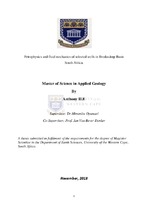Petrophysics and fluid mechanics of selected wells in Bredasdorp Basin South Africa
Abstract
Pressure drop within a field can be attributed to several factors. Pressure drop occurs when fractional forces cause resistance to flowing fluid through a porous medium. In this thesis, the sciences of petrophysics and rock physics were employed to develop understanding of the physical processes that occurs in reservoirs. This study focussed on the physical properties of rock and fluid in order to provide understanding of the system and the mechanism controlling its behaviour. The change in production capacity of wells E-M 1, 2, 3, 4&5 prompted further research to find out why the there will be pressure drop from the suits of wells and which well was contributing to the drop in production pressure. The E-M wells are located in the Bredasdorp Basin and the reservoirs have trapping mechanisms of stratigraphical and structural systems in a moderate to good quality turbidite channel sandstone. The basin is predominantly an elongated north-west and south-east inherited channel from the synrift sub basin and was open to relatively free marine circulation. By the southwest the basin is enclose by southern Outeniqua basin and the Indian oceans. Sedimentation into the Bredasdorp basin thus occurred predominantly down the axis of the basin with main input direction from the west. Five wells were studied E-M1, E-M2, E-M3, E-M4, and E-M5 to identify which well is susceptible to flow within this group. Setting criteria for discriminator the result generated four well as meeting the criteria except for E-M1. The failure of E-M1 reservoir well interval was in consonant with result showed by evaluation from the log, pressure and rock physics analyses for E-M1.iv Various methods in rock physics were used to identify sediments and their conditions and by applying inverse modelling (elastic impedance) the interval properties were better reflected. Also elastic impedance proved to be an economical and quicker method in describing the lithology and depositional environment in the absence of seismic trace.

